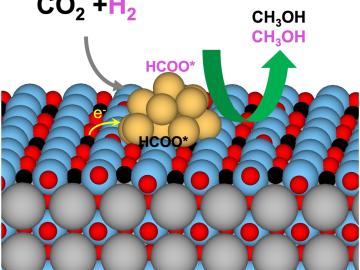Filter News
Area of Research
Date
News Topics
- 3-D Printing/Advanced Manufacturing (7)
- Advanced Reactors (3)
- Artificial Intelligence (18)
- Big Data (5)
- Bioenergy (7)
- Biology (9)
- Biomedical (5)
- Biotechnology (4)
- Buildings (10)
- Chemical Sciences (8)
- Clean Water (3)
- Climate Change (14)
- Composites (3)
- Computer Science (15)
- Critical Materials (2)
- Decarbonization (15)
- Emergency (1)
- Energy Storage (7)
- Environment (16)
- Exascale Computing (4)
- Fossil Energy (2)
- Frontier (5)
- Fusion (4)
- Grid (5)
- High-Performance Computing (12)
- Isotopes (5)
- ITER (1)
- Machine Learning (7)
- Materials (10)
- Materials Science (8)
- Mathematics (1)
- Microscopy (1)
- Nanotechnology (2)
- National Security (12)
- Net Zero (4)
- Neutron Science (8)
- Nuclear Energy (6)
- Partnerships (8)
- Physics (2)
- Polymers (3)
- Quantum Computing (7)
- Quantum Science (9)
- Security (2)
- Simulation (10)
- Space Exploration (2)
- Statistics (2)
- Summit (4)
- Sustainable Energy (11)
- Transportation (8)
Media Contacts

Researchers tackling national security challenges at ORNL are upholding an 80-year legacy of leadership in all things nuclear. Today, they’re developing the next generation of technologies that will help reduce global nuclear risk and enable safe, secure, peaceful use of nuclear materials, worldwide.

A team of scientists led by ORNL found an unconventional way to improve catalysts made of more than one material. The solution demonstrates a path to designing catalysts with greater activity, selectivity and stability.
ORNL drone and geospatial team becomes first to map the Coca River in the Amazon basin as erosion and sediment threaten Ecuador’s lands.

Researchers at ORNL are developing battery technologies to fight climate change in two ways, by expanding the use of renewable energy and capturing airborne carbon dioxide.

A team of researchers including a member of the Quantum Science Center at ORNL has published a review paper on the state of the field of Majorana research. The paper primarily describes four major platforms that are capable of hosting these particles, as well as the progress made over the past decade in this area.

Researchers at the Department of Energy’s Oak Ridge National Laboratory met recently at an AI Summit to better understand threats surrounding artificial intelligence. The event was part of ORNL’s mission to shape the future of safe and secure AI systems charged with our nation’s most precious data.

A team led by researchers at ORNL explored training strategies for one of the largest artificial intelligence models to date with help from the world’s fastest supercomputer. The findings could help guide training for a new generation of AI models for scientific research.

When scientists pushed the world’s fastest supercomputer to its limits, they found those limits stretched beyond even their biggest expectations. In the latest milestone, a team of engineers and scientists used Frontier to simulate a system of nearly half a trillion atoms — the largest system ever modeled and more than 400 times the size of the closest competition.

ORNL researchers have produced the most comprehensive power outage dataset ever compiled for the United States. This dataset, showing electricity outages from 2014-22 in the 50 U.S. states, Washington D.C. and Puerto Rico, details outages at 15-minute intervals for up to 92% of customers for the eight-year period.

Joseph Chapman, a research scientist in quantum communications at ORNL, was given the Physical Review Applied Reviewer Excellence 2024 award for his work as a peer reviewer for the journal Physical Review Applied.




